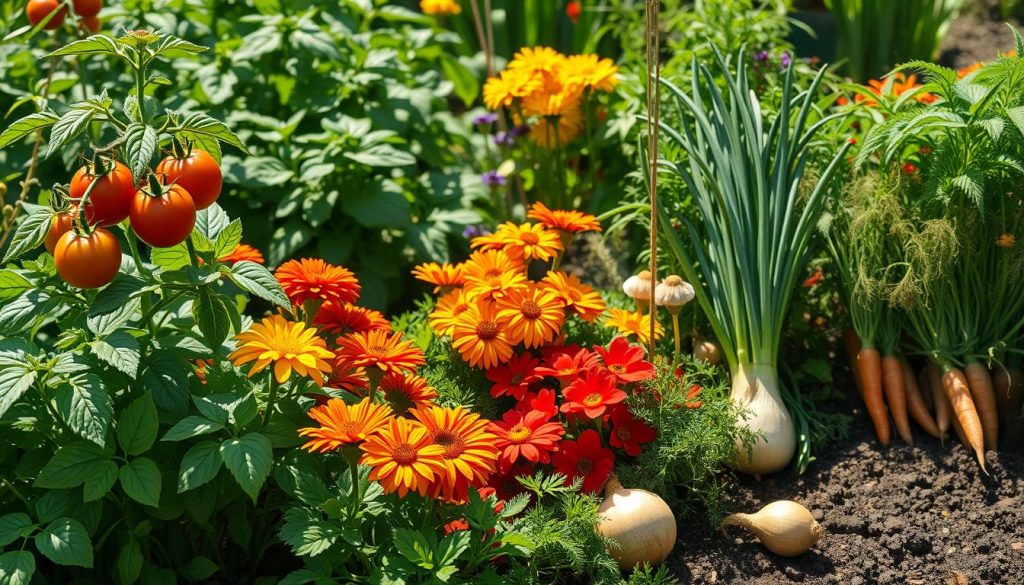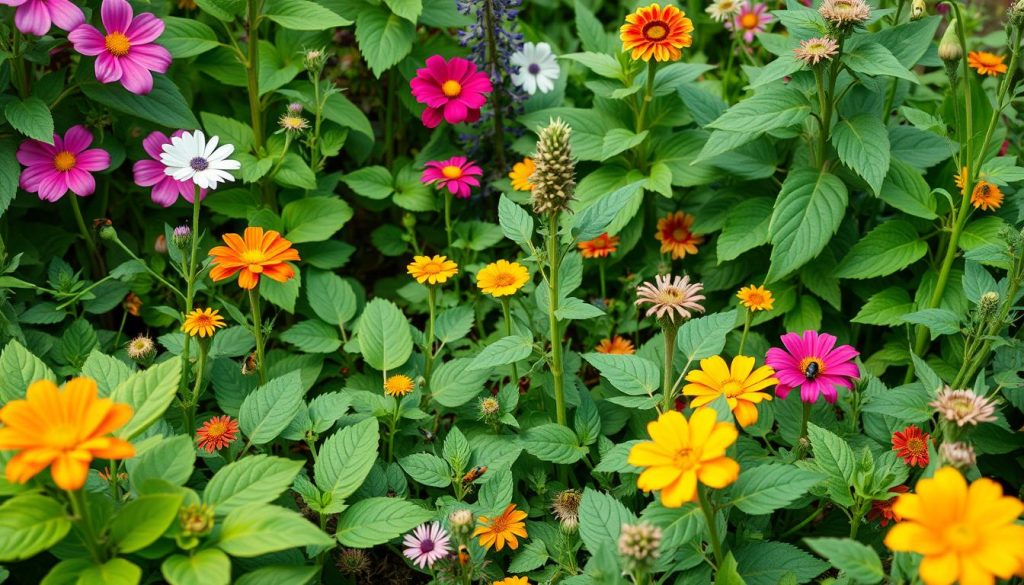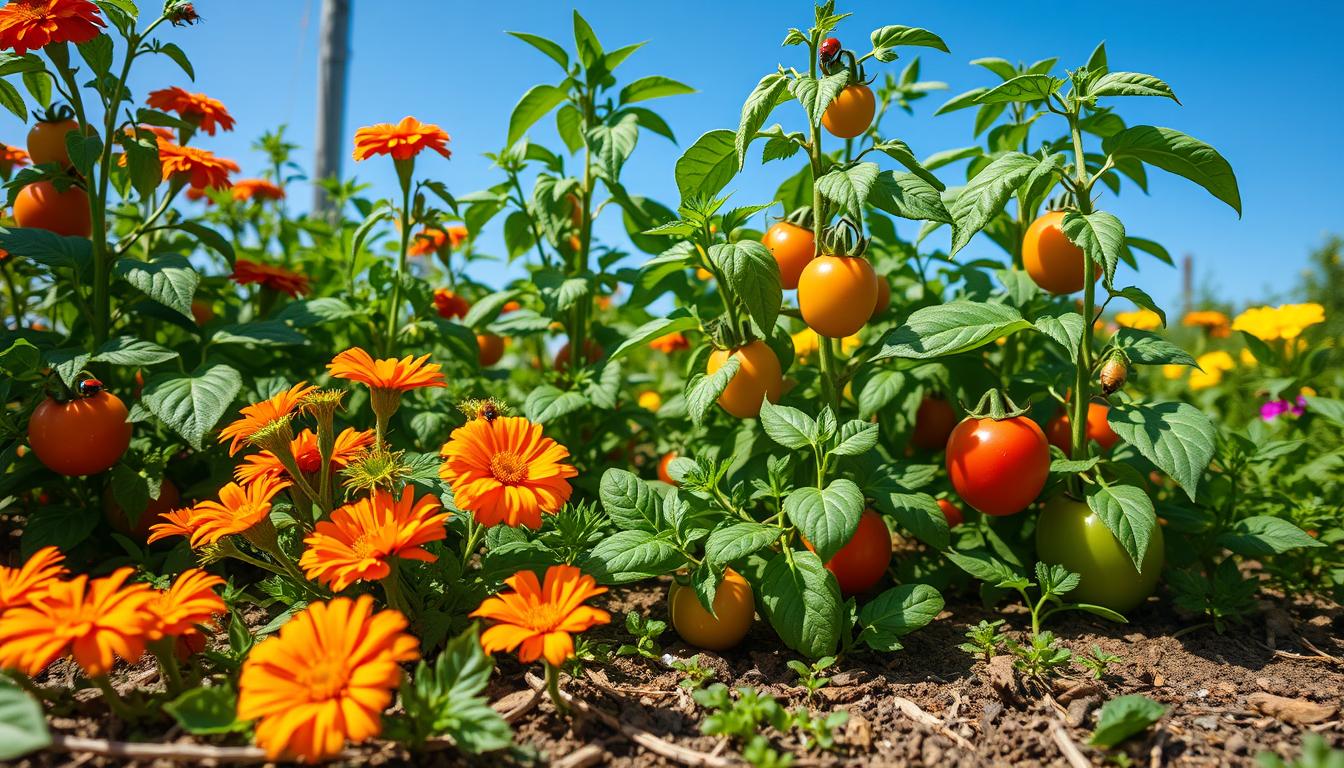I’m excited to share the benefits of companion planting for pest control. It’s a natural way to keep your garden healthy without using harsh chemicals. This method helps create a balanced ecosystem in your garden.
Companion planting is easy to use and can make your garden thrive. It’s a natural way to keep pests away and improve plant growth. I’ve seen it work wonders in my garden, and I’m here to share how you can use it too.
Exploring companion planting has taught me a lot about gardening. It’s about using plants to repel pests and create a balanced garden. In this article, I’ll share my knowledge and give you tips to use companion planting in your garden. We’ll focus on organic gardening tips and natural pest control methods.
What is Companion Planting?
Companion planting is a way to grow different plants together for benefits like pest control and better growth. It’s a key part of organic gardening. By learning about it, gardeners can make their gardens more effective and eco-friendly.
It helps keep pests away, attracts good bugs, and can even make food taste better. For example, basil and mint can keep pests off veggies. Marigolds and sunflowers attract bugs that eat pests.
Understanding the Basics
To start with companion planting, you need to know about different plant pairs. Some common ones are:
- Pest-repelling plants, like basil or mint, that keep pests away from veggies
- Beneficial insect attractants, such as marigolds or sunflowers, that draw in helpful bugs
- Pest-resistant plant combinations for a strong pest control plan
Benefits for Pest Management
Companion planting has many advantages for managing pests. It cuts down on chemical use, boosts crop yields, and improves soil health. By using the right plants together, gardens can grow healthier and pest-free.

Popular Companion Planting Combinations
Exploring companion planting is exciting. I’m eager to share some top picks for managing pests sustainably. A good guide helps gardeners build a balanced ecosystem. This way, plants grow well and pesticides are less needed.
Here are some of my top picks:
- Tomatoes and basil: This duo keeps pests like whiteflies and aphids away from tomatoes. It’s a prime example of managing pests sustainably.
- Marigolds and vegetables: Marigolds ward off nematodes and other pests when planted with veggies. It’s a step towards a greener garden.
- Carrots and onions: Growing carrots and onions together boosts their health and fights pests. It’s a smart choice for any garden.
These pairings show how companion planting can make gardens better. By following a guide and adding these combos, you can cut down on pesticides. This approach supports healthy plant growth and eco-friendly pest control.

How Companion Planting Affects Pests
Companion planting is a big help in controlling pests in gardens. It uses plant partnerships to keep pests away without chemicals. This method also attracts good bugs that eat pests.
Some plants, like garlic or hot peppers, keep pests away. Garlic fights off aphids, and hot peppers keep spider mites away. Adding these plants to your garden makes a natural pest barrier.
Repellent Plants
- Garlic: repels aphids and other soft-bodied insects
- Hot peppers: deter spider mites and other pests
- Basil: repels flies and mosquitoes
Companion planting also draws in helpful bugs. Ladybugs, lacewings, and wasps are examples. These bugs help control pests when they’re welcomed in your garden.

Attracting Beneficial Insects
Understanding how plants work together to fight pests is key. It leads to a better, greener way to manage pests. I’m eager to see how plant partnerships can make my garden even better.
Setting Up a Companion Planting Strategy
To make your garden thrive, setting up a companion planting strategy is key. It uses organic gardening tips and companion planting for pest control. By picking the right plants and planning your garden, you can grow healthy plants and keep pests away.
When picking plants, think about how well they work together. Some plants keep pests away, while others attract good bugs. Mixing these plants creates a strong defense for your garden. Also, make sure each plant has enough space and grows well with others.
Choosing the Right Plants
- Research plants that are native to your region and suitable for your climate
- Consider the specific needs of each plant, such as sunlight and watering requirements
- Look for plants that provide multiple benefits, such as pest control and nutrient enrichment
By following these tips and using organic gardening and companion planting, you can have a thriving garden. Plan your garden layout carefully, considering each plant’s mature size and growth habits. With some planning and research, you’ll enjoy a full harvest and a garden free from pests.
Real-Life Success Stories
Reflecting on my journey with companion planting, I see its big impact on my garden. It has cut down my use of chemical pesticides. This has made my garden more sustainable and balanced.
It has also made my plants healthier. Plus, it has attracted beneficial insects, which is a big plus.
Companion planting is great for managing pests sustainably. It pairs plants that repel pests or attract good insects. For instance, marigolds with tomatoes can keep nematodes away. Basil and mint can chase off aphids and other pests.
My Experience with Companion Planting
My experience with companion planting has been amazing. I’ve seen fewer pests and better crops. It’s made my garden more diverse and strong.
Others Who Have Benefited
Many gardeners and farmers have seen the benefits too. Organic farmers have better crops and fewer pests. Some have even used less chemical pesticides. This makes farming more sustainable and eco-friendly.
- Improved crop yields
- Reduced pest populations
- Increased biodiversity
- More sustainable and balanced ecosystem
Tips for Effective Companion Planting
Starting your companion planting journey? Keep a few things in mind. The season your plants need is key. Some veggies do best in spring, others in summer or fall. Match your plants with the right seasons for the best growth and pest control.
Avoiding Common Mistakes
Don’t make common mistakes that can harm your garden. Planting the wrong plants together can lead to competition and poor growth. Also, make sure plants have enough space to grow well and work together. Avoid these mistakes for a healthy garden.
Resources for Further Learning
Want to learn more about companion planting? There’s plenty of resources out there. Gardening books, online tutorials, and local gardening groups can all help. Keep learning to make your garden the best it can be.

